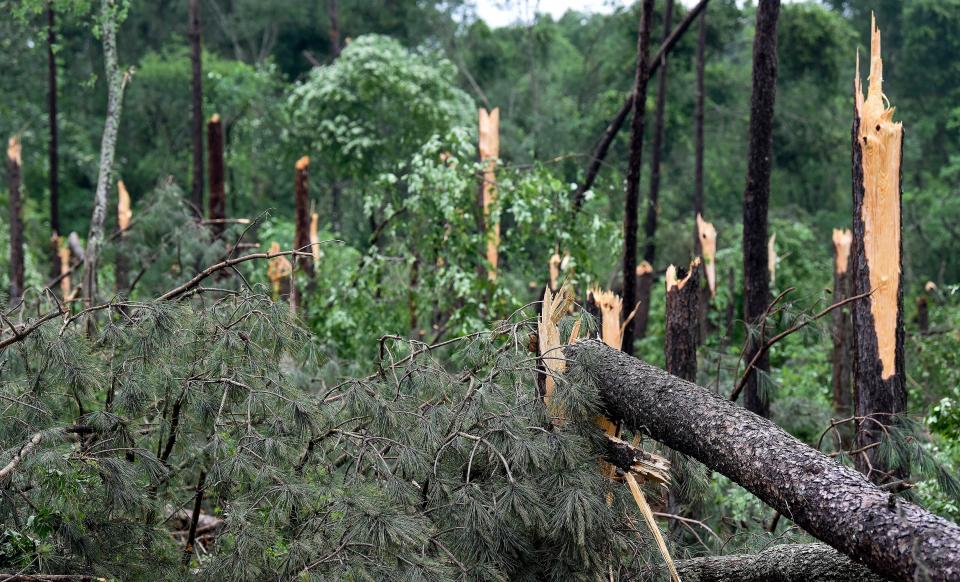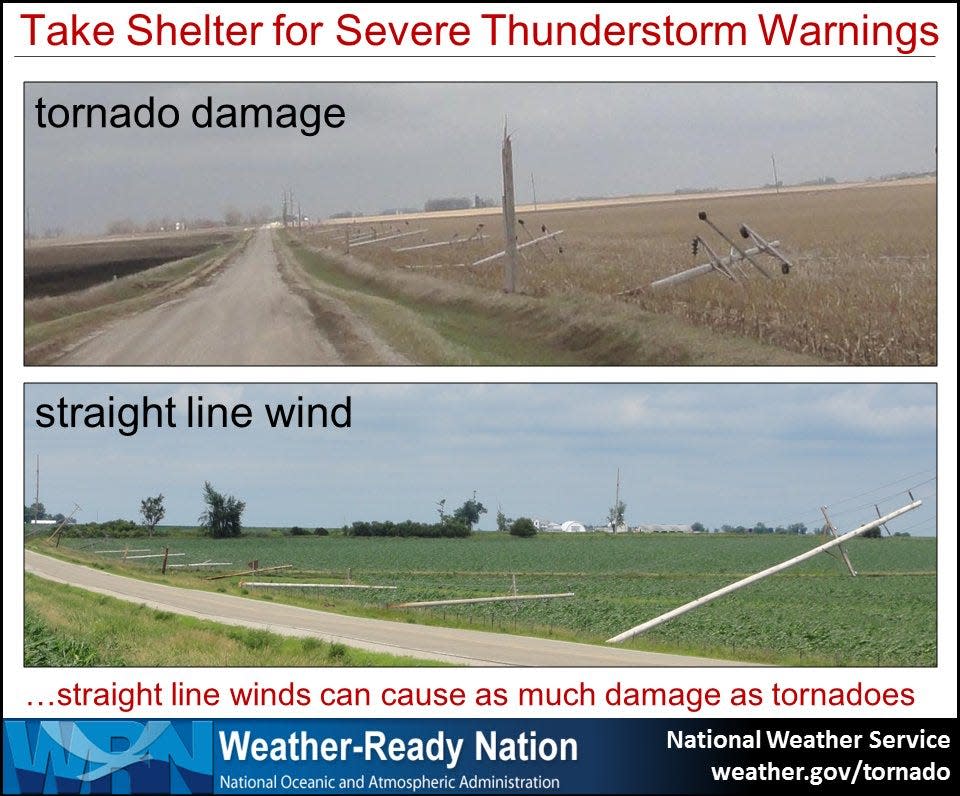Straight-line winds as dangerous as tornadoes, but often overlooked by the public
A menace lurks in the skies during periods of unsettled and severe weather. A menace unheralded by angry, red icons flashing on television screens or sirens blaring outside.
Straight-line winds cause more damage in Alabama — and across the country — than tornadoes, according to National Weather Service data. Any strong to severe thunderstorm can produce the winds, considered dangerous when they reach 50 to 60 miles per hour. Stronger storms can spawn winds of more than 100 miles per hour, approaching the high-end speeds of an EF-1 tornado.
And most people are unaware of the dangers associated with the winds, said Josh Johnson, chief meteorologist for Montgomery’s WSFA.
“It’s psychological,” he said. “We have done a great job of educating the public on the dangers of tornadoes. But straight-line winds occur more often and can be at speeds approaching EF-0 and EF-1 tornadoes.

“Straight -line winds can cause extensive damage and can lead to serious injuries.”
To put it in perspective, an EF-0 tornado has winds of 65-85 mph and an EF-1 has winds of 86-110 mph
'I was so scared': Cleanup begins after storms rage through central Alabama
More: Everything you need to know about invasive hammerhead worms but were too freaked out to ask
Minimal hurricane-force winds are 74 mph with Category 1 hurricanes in the 74-95 and Category 2 hurricanes in the 96 to 110 mph ranges.
People should not become “fascinated,” by the image or idea of a tornado, said Ernie Baggett, director of the Autauga County Emergency Management Agency.

“It doesn’t matter if they are blowing in a circle or blowing in a straight line, 80 mph winds are 80 mph winds,” he said. “If it’s your roof that is blown off, or you home that has a tree blown onto it, it doesn’t make a difference.”
Alabama is in the middle of severe weather season, March through May, with April being the month where the most tornadoes have occurred.
The Threat
Severe thunderstorm winds account for half of all severe weather damage reports in the 48 contiguous states, according to the National Oceanic and Atmospheric Association. Each year an average of $17 billion in property damage is reported in the nation from wind damage, data from the Insurance Information Institute shows. That amount is almost equal to the annual damage total for hurricanes.
In Alabama, a spate of severe weather events beginning in mid-March and occurring almost on a weekly basis has caused widespread straight-line wind damage.
The incidents include:
March 18: The Big Oak Mobile Home Park in Atmore received significant damage due to straight-line winds estimated at 90 to 100 mph, after storm assessments from the NWS office in Mobile show. Ten people were injured, two with serious injuries, according to media reports and the Escambia County EMA. Nine mobile homes were destroyed.
March 22: Damage in Hale County near Moundville was caused by straight-line winds according to the NWS office in Birmingham. Media and Hale County EMA reports estimate the damages total $1 million. The winds were estimated to be 76 mph causing uprooted trees and more than 30 homes being damaged.
March 30: straight-line winds estimated at 85-90 mph caused damage in Lauderdale County, near the Cloverdale community, according to the NWS office in Huntsville.
On May 4, Prattville was struck by a straight-line wind event as well as an EF-1 tornado. The tornado, packing winds of up to 100 mph touched down in east Prattville crossed I-65 to Millbrook then crossed the Alabama River and dissipated near the Montgomery Zoo, the NWS office in Birmingham’s survey showed. Damage in the Woodland Heights area, where trees were downed and several homes were damaged, was due to straight-line winds, the Autauga EMA says.

Jenny Bennet was visiting a friend who lived on Nichols Street when the winds hit about 6:15 p.m.
“It was raining real hard and the wind just came out of nowhere,” she said, then. “We had the front door open looking out and just a wall of water and wind hit. The wind was roaring so we knew it was a tornado.”
That’s also a misnomer, telling the difference between straight-line winds and tornadoes. Winds of 75 mph and higher can produce the same "freight train" roar often associated with tornadoes.
“Some people get very upset when you tell them their damage was caused by straight-line winds,” said Baggett. “They will point to twisted off trees, say there was a roaring sound and insist it was a tornado. To many people, the only thing that can cause storm damage has to be a tornado.”
Another level of danger from straight-line winds is they can cover a large area.
“Tornadoes cause damage in a specific area,” Johnson said. “Given the right setup, a severe weather system can produce straight-line winds along a vast area, along a squall line as the system moves through the area.
“I remember, two or three years ago, a straight-line wind event hitting Chilton, Coosa and Tallapoosa counties. It was just a huge area of straight-lines winds that downed more than 500 trees.”
More: The heart of Dixie Alley: Why Alabama tornadoes are the deadliest in the nation
Deadly gaps: Weather radar's inability to see everything is an issue
According to the NWS, straight-line winds are thunderstorm winds that have no rotation, not a tornado. They can take common forms, including:
Downbursts: Are a common cause of wind damage from a thunderstorm. They can reach over 100 mph and are caused by air being dragged down by precipitation. When the air reaches the ground, it spreads outward across the surface of the land it encounters in a straight line.
Derecho: A derecho is a very long-lived and damaging thunderstorm. A storm is classified as a derecho if wind damage swath extends more than 240 miles and has wind gusts of at least 58 mph or greater along most of the length of the storm's path.
The derecho is a beast of a thunderstorm. It’s an oversimplification but think of them as inland hurricanes. A monster derecho struck the Midwest in August of 2020, becoming the “costliest severe thunderstorm event in United States history," according to the NWS.
“A long-lived line of severe storms known as a "derecho" produced severe wind damage across portions of South Dakota, Nebraska, Iowa, Illinois, Wisconsin, Indiana, Michigan, and Ohio on Monday, Aug. 10, 2020.” An NWS after storm report reads. “A large area from central Iowa to north-central Illinois experienced wind gusts of 70-80 mph, with maximum wind gusts of over 100 mph in a few isolated areas.
“This particularly significant derecho event caused widespread power outages and downed trees, damaged structures, toppled semi-trailers, and flatted crops over a large area. Damaging winds covered an area of at least 90,000 square miles, which is home to over 20 million people. In some locations, these damaging wind gusts occurred during a 30-45 minute period. The most extreme damaging wind gusts (those estimated over 100 mph) occurred in portions of central and eastern Iowa as well a few isolated locations along the Iowa/Illinois border and in Illinois.”
Keeping safe during storms
When any form of severe weather threatens its time to go back to the rules drilled into most of us since elementary school; be alert for weather warnings and updates. If a tornado warning is issued for your area go to the lowest floor of your home in a central room away from windows.
Severe thunderstorm warnings should be treated the same as tornado warnings, said Tamara Croom, deputy director for the Tuscaloosa County EMA.
“Severe thunderstorms are dangerous as well because of the high winds, large hail and heavy rain the severe thunderstorm can produce,” she said.
Preparation is the key, she said. Have a plan in place for your family, what to do at home or if you are away when severe weather is in the area. The plan needs to cover where the family will go in the home and how to meet up after a storm if you are away from home. And practice those steps, she said.
Make sure you know even the simple stuff, like the difference between a weather watch or a weather warning.
“We tell people that a watch is when you are preparing for a meal,” Croom said. “A warning means all the ingredients have come together and it’s time to eat. It’s time to take action.”
Every home, school, church and business needs a weather radio with battery backup, to get the most up-to-date information. Dozens of apps can be downloaded to your smart device to give you weather information for your area.
Life-saving tips from the National Weather Service
Get in: If you are outside, get inside. If you're already inside, get as far into the middle of the building as possible.
Get down: Get underground if possible. If you cannot, go to the lowest floor possible.
Cover up: Flying and falling debris are a storm's number one killer. Use pillows, blankets, coats, helmets to cover up and protect your head and body from flying debris.
Don't panic! “When severe weather threatens, you need to be aware,” Johnson said. “Put your plan into action. Go to that safe place. Have some device with you so you can get updates, even if the power goes out. Take action as quickly as possible when your area is threatened.
Contact Montgomery Advertiser reporter Marty Roney at mroney@gannett.com.
This article originally appeared on Montgomery Advertiser: In Alabama, straight-line winds cause more damage than tornadoes

